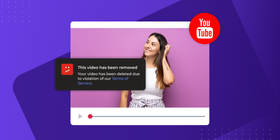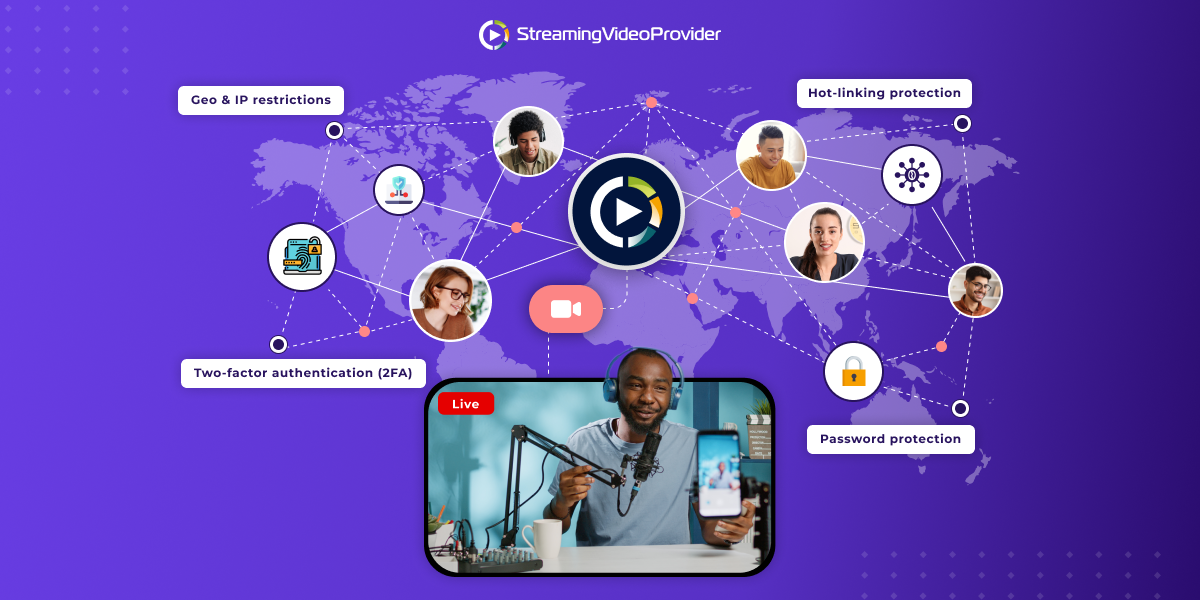How To Create A Private YouTube Channel: 2024 Tutorial
YouTube is a hugely popular platform for sharing video content publicly online. However, did you know it’s also a nice way to store private video content? In the post below, we will show you how to create a private YouTube channel. We will also be listing some great reasons why you might want one for yourself!

What is the difference between public and private videos?
To start with the obvious, public videos are available for anyone to find online, whereas private videos are not. The exception to that rule is that you can invite specific users to view your private videos.
Private videos will not appear in search results for public users to find. This means that they aren’t suitable for monetization, sharing, or embedding into websites.
Public videos are the default setting when uploading to YouTube. These videos are visible to anyone searching the platform. These videos can be embedded into your website and are able to be shared by anyone.
So, can you make YouTube videos private that have already been uploaded? Absolutely!
The visibility of a video can be changed at any time. You can change your public video to private and vice versa with immediate effect.
Reasons to have a private YouTube channel
I know what you’re thinking — why on earth would anyone put time into a private video channel that nobody can see!?

There are many reasons why you would want to keep your videos private.
Here are some common reasons why businesses and general users create YouTube private videos and private channels:
- Securely store family footage
- Personal archiving
- Content for future marketing campaigns
- Share internal training videos with employees
- Upload to the cloud to save storage space
YouTube is both free and easy to use which is why many are using it for private video storage.
Limitations when using YouTube for private video storage
YouTube is a fantastic option for those looking to casually upload private content for storage. However, there are a few limitations when using YouTube as a private video sharing platform.

Here are some limitations to keep in mind when choosing YouTube for private videos:
- Repeatedly breaking ToS can result in channel deletion
- Future YouTube policy changes may impact your content
- No option to password protect a video
- Can only share private access with other Google accounts (50 users only)
- Limited visibility options for unlisted and private videos
When choosing a service such as YouTube to store your content, you accept their terms of service. This means that if any of your content violates the ToS, you are at risk of having your content removed. So, it is highly recommended to look at all the rules of how YouTube stores customers' data in advance".
How to create a private YouTube channel step-by-step
- Head over to YouTube and either sign in with an existing account, or create a new one.

- If you are a new user, go through the signup wizard. You may then be asked if you wish to allow users to find your channel via your email address. Select No, and proceed with the setup process.
- When you have finished filling out the signup form, you will need to verify your email address.
- Once you have finished the signup process and have signed in, click on Your Videos from the left panel.

- Once you have clicked on the Your Videos link, you will be viewing the Content section. Here you will see all of the videos that have been uploaded to your channel
- Under Visibility, click on Private in order to make a chosen video private. You can also select multiple videos at once by ticking the box to the left of each video.

- If you want to share a private YouTube video, click on the Share Privately link to input the recipient's email address. You can also share a private YouTube channel by sharing the channel URL. However, any videos set to Private will not be visible.

YouTube previously offered a channel-wide option where users could set discovery to private. As this has recently changed, it is best to make sure that you check your preferences manually.
Making your YouTube playlists private
As you are aiming to have a private YouTube channel, you may want to adjust your playlist settings too.
You can access this setting on YouTube by clicking on your profile picture at the top right. Then, click Settings and bring up the screen shown below.

When you have the Privacy menu selected from the left side of the screen, you will see Playlists and Subscriptions options. These are important settings to change when trying to make a YouTube page private.
From here, you can change the setting to keep all of your saved playlists private. You can also keep all of your channel subscriptions private by choosing the second option on the page.
Creating a private YouTube channel to keep your content safe is a good option. However, using a dedicated streaming video platform opens up many more options as you can see below
Private YouTube Channel | StreamingVideoProvider | |
Video Uploads | Manual/batch uploading | Batch uploading,FTP/HTTP uploading, auto-sync FTP folder |
Access from China | Blocked | Video and streaming fully accessible |
Custom Video Player | Standard YouTube player | Fully customizable, 100% white label, use your own branding |
Security and Access Controls | 2FA, encryption, invite a limited number of users to view private videos | Military-grade encryption, geo blocking, domain name access, IP restrictions, password protection, 2FA |
Video Management | Very limited | Full video CMS, smart search engine, smart media publishing |
You may want to password protect a YouTube channel or even sell videos on YouTube which isn’t possible currently.
Premium video platforms such as StreamingVideoProvider are ideal for users looking to password protect their YouTube videos. Services like ours allow you to gain more control of your video content and open up more monetization options.
Choosing the most comprehensive, scalable and secure platform is something your future business will thank you for. Wouldn’t you love to be able to password protect certain videos or have the option to charge for access? All of this is possible with StreamingVideoProvider.
Also, with a service such as ours, your content will always be your content without the risk of censorship or demonetization.
FAQs
Creating a private YouTube channel doesn’t cost anything. There is the risk of having your content deleted by YouTube which may mean financial losses for your company.
It can be quite confusing to new users hearing about public, private and unlisted YouTube videos. Let's take a look at what the key differences are between each.
A public video is a video that anyone can find on YouTube in search and through related videos.These are videos that can be monetized allowing creators to earn ad revenue from their content.
A private video is a video that can only be seen by the account owner, or an invited YouTube user.
An unlisted video is a video that isn’t visible to anyone browsing YouTube. This includes users using search, or browsing your channel’s content. The only way someone can view or share your unlisted video is by having the video’s direct link.
If your YouTube account has monetization enabled, you can enable monetization for unlisted videos that are shared with your audience. However, any money made will be significantly less compared to a public video.
Monetization on private videos should be avoided as no audience will be viewing it. Because of this, no ad revenue will be generated via ad impressions.
If you decide to change your private videos to public, you can still enable monetization from that point on.
Conclusion
Using YouTube to casually store and archive your video content privately is becoming more common. Both businesses and other users are making the most of using YouTube to store and share their content to select users.
But, if you’re looking for better video management, broader monetization and additional security options, try a business video hosting provider.
This allows you to set up a PPV paywall when you want to monetize your content. You keep all of the revenue (no sharing!) and you can sell tickets, subscriptions, and more.
A business video platform such as StreamingVideoProvider also gives you access to a comprehensive video CMS to manage your content. There is also advanced video protection to ensure your private videos stay private.
Ultimately, YouTube is very capable for video hosting, but very limited with it can offer. When it comes to private video and video access in general, it is worth weighing all the pros and cons before trusting this platform with your video content.
References & Further reading
- All Of Your Questions About Uploading And Sharing Private Video, Answered
- Best Video Editing Software: Top Tools
- How To Earn Money On YouTube
- How To Make A Secure Video Subscription (Membership) Site Today
- How To Get Started With YouTube
- Password Protecting YouTube Videos

You Can Sell Tickets To Your Live Events
Try It Now








DON’T MISS OUT
Get updates on new articles, webinars and other opportunities: